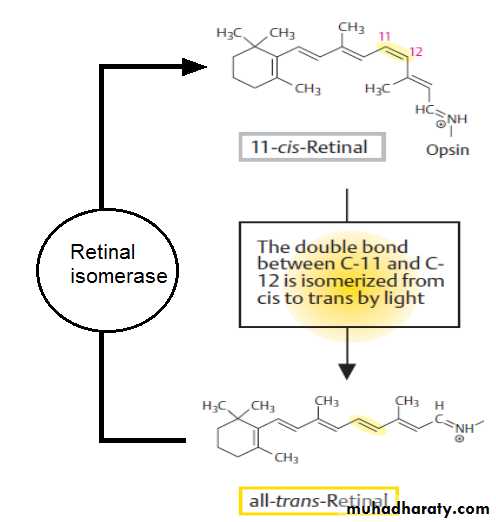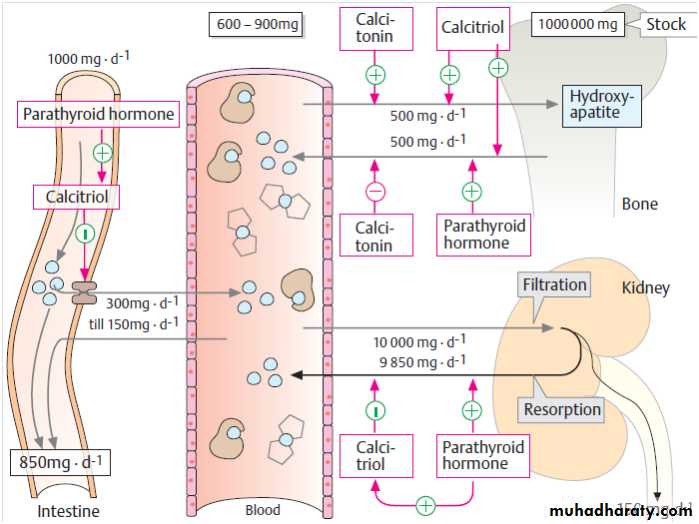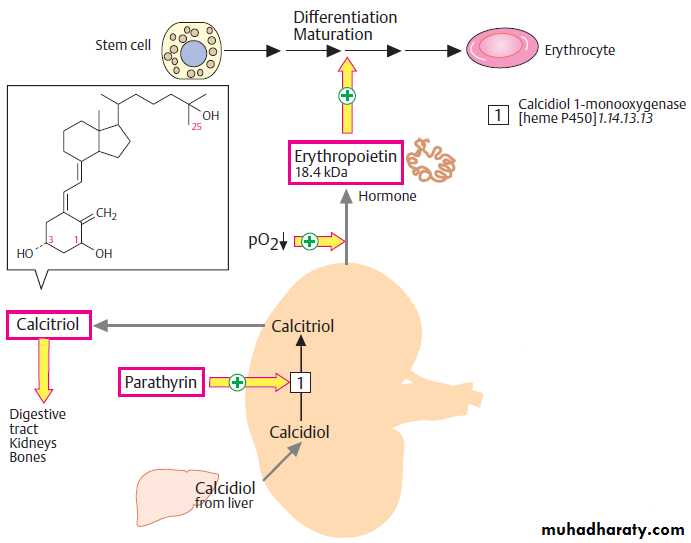3- Fat- soluble vitamins:
Vitamins are classified as either lipid-soluble or water-soluble. The lipid-soluble vitamins include vitamins A, D, E, and K, all of which belong to the isoprenoids .Vitamins supply:
A healthy diet usually covers average daily vitamin requirements. By contrast, malnutrition, malnourishment (e. g., an unbalanced diet in older people, malnourishment in alcoholics, ready meals), or resorption disturbances lead to an inadequate supply of vitamins from which hypovitaminosis, or in extreme cases avitaminosis, can result. Medical treatments that kill the intestinal flora-e. g., antibiotics— can also lead to vitamin deficiencies (K, B12,biotin) due to the absence of bacterial vitamin synthesis. Since only a few vitamins can be stored (A, D, E, B12), a lack of vitamins quickly leads to deficiency diseases. These often affect the skin, blood cells, and nervous system. The causes of vitamin deficiencies can be treated by improving nutrition and by administering vitamins in tablet form. An overdose of vitamins only leads to hypervitaminoses, with toxic symptoms, in the case of vitamins A and D. Normally, excess vitamins are rapidly excreted with the urine.
1-Vitamin A (retinol):
Vit A is the parent substance of the retinoid, which include retinal and retinoic acid. The retinoid also can be synthesized by cleavage from the provitamin (β-carotene). Retinoid are found in meat-containing diets, whereas β carotene occurs in fruits and vegetables (particularly carrots). Retinal is involved in visual processes as the pigment of the chromo protein rhodopsin .Retinol
Retinoic acid, like the steroid hormones, influences the transcription of genes in the cell nucleus. It acts as a differentiation factor in growth and development processes. Vitamin A deficiency can result in night blindness, visual impairment, and growth disturbances.Two types of photoreceptor cell are found in the human retina—rods and cones. Rods are sensitive to low levels of light, while the cones are responsible for color vision at higher light intensities. Signaling substances and many proteins are involved in visual processes. Initially, a light-induced cis–trans isomerization of the pigment retinal triggers a conformational change in the membrane protein rhodopsin. Via the G protein transducin, which is associated with rhodopsin, an enzyme is activated that breaks down the second messenger cGMP. Finally, the cGMP deficiency leads to hyperpolarization of the light-sensitive cell, which is registered by subsequent neurons as reduced neurotransmitter release.
A. Photoreceptor
The cell illustrated is a rod cell, which has a structure divided by membrane discs into which the 7-helix receptor rhodopsin is integrated .In contrast to other receptors in the 7-helix class ,rhodopsin is a light-sensitive chromoprotein. Its protein part is opsin, and contains the aldehyde retinal an isoprenoid which is bound to the ε-amino group of a lysine residue as an aldimine. The light absorption of rhodopsin is in the visible range, with a maximum at about 500 nm. The absorption properties of the visual pigment are thus optically adjusted to the spectral distribution of sunlight.
Absorption of a photon triggers isomerization from the 11-cis form of retinal to alltrans- retinal. Within milliseconds, this photochemical process leads to an allosteric conformational change in rhodopsin. The active conformation (rhodopsin*) binds and activates the G protein transducin. The signal cascade that now follows causes the Rod cells to release less neurotransmitter (glutamate) at their synapses (In the nervous system, a synapse is a structure that permits a neuron to pass an electrical or chemical signal to another cell ) The adjoining bipolar neurons register this change and transmit it to the brain through the optical nerve as a signal for light.
B. Signal cascade
DarkRod cells that are not exposed to light contain relatively high concentrations (70 µM) of the cyclic nucleotide cGMP (3_,5_-cycloGMP), which is synthesized by a guanylate cyclase . The cGMP binds to an ion channel in the rod membrane (bottom left) and thus keeps it open. The inflow of cations (Na+, Ca2+) depolarizes the membrane and leads to release of the neurotransmitter glutamate at the synapse .
Light
When the G protein transducin binds to light-activated rhodopsin* , it leads to the GDP that is bound to the transducin being exchanged for GTP. In transducin* that has been activated in this way, the GTP-containing α_subunit breaks off from the rest of the molecule and in turn activates a membrane cGMP phosphodiesterase . This hydrolyzes cGMP to GMP and thus reduces the level of free cGMP within milliseconds. As a consequence, the cGMP bound at the ion channel dissociates off and the channel closes. As cations are constantly being pumped out of the cell, the membrane potential falls and hyperpolarization of the cell occurs, which interrupts glutamate release.
Regeneration.
After exposure to light, several processes restore the initial conditions:1. The α_subunit of transducin* inactivates itself by GTP hydrolysis and thus terminates the activation of cGMP esterase.
2. The reduced Ca2+ concentration causes activation of guanylate cyclase, which increases the cGMP level until the cation channels reopen.
3. An isomerase transfers all-trans -retinal to the 11-cis -form, in which it is available for the next cycle. A dehydrogenase can also allow retinal to be supplied from vitamin A (retinol).
Vitamin A Deficiency :
Deficiency of vitamin A results in night blindness (rod cells are responsible for vision in low light), metaplasia (Metaplasia (Greek: "change in form") is the reversible replacement of one differentiated cell type with another mature differentiated cell type )of the corneal epithelium, dry eyes, bronchitis, pneumonia, and follicular hyperkeratosis.follicular hyperkeratosis
2-Vitamin D (calciol, cholecalciferol):
Vitamin D (calciol, cholecalciferol) is the precursor of the hormone calcitriol (1,25-dihydroxycholecalciferol);Together with two other hormones regulates the calcium metabolism .
Calcium homeostasis :
Ca2+ metabolism is balanced in healthy adults. Approximately 1g Ca2+ is taken up per day, about 300 mg of which is resorbed. The same amount is also excreted again. The amounts of Ca2+ released from bone and deposited in it per day are much smaller. Milk and milk products, especially cheese, are particularly rich in calcium. Calcitriol and parathyroid hormone, on the one hand, and calcitonin on the other, ensure a more or less constant level of Ca2+ in the blood plasma and in the extracellular space (80–110 mg/l or 2.0–2.6 mM ).
The peptide parathyroid hormone (PTH ) and the steroid calcitriol. promote direct or indirect processes that raise the Ca2+ level in blood. Calcitriol increases Ca2+ resorption in the intestine and kidney by inducing transporters. Parathyroid hormone supports these processes by stimulating calcitriol biosynthesis in the kidneys
In addition, it directly promotes resorption of Ca2+ in the kidneys and Ca2+ release from bone .The PTH antagonist calcitonin {Calcitonin is a 32-amino acid linear polypeptide hormone that is produced in humans primarily by the parafollicular cells (also known as C-cells) of the thyroid, It acts to reduce blood calcium (Ca2+), opposing the effects of parathyroid hormone or counteracts these processes.
Calciol can be synthesized in the skin from 7-dehydrocholesterol, an endogenous steroid, by a photochemical reaction.
Vitamin D deficiencies only occur when the skin receives insufficient exposure to ultraviolet light and vitamin D is lacking in the diet. Deficiency is observed in the form of rickets in children and osteomalacia in adults. In both cases, bone mineralization is disturbed.
Vitamin E (tocopherol):
Vit E and related compounds only occur in plants (e. g., wheat germ). They contain what is known as a chromane ring. In the lipid phase, vitamin E is mainly located in biological membranes, where it acts as an antioxidant . it protects unsaturated lipids against ROS (reactive oxygen species) and other radicals.Reactive oxygen species (ROS)
The dioxygen molecule (O2) contains two unpaired electrons, it is a diradical. Despite this, O2 is relatively stable due to its special electron arrangement. However, if the molecule takes up an extra electron (a), the highlyreactive superoxide radical ( O2 –) arises. Another reduction step (b) leads to the peroxide anion (O2 2–), which easily binds protons and thus becomes hydrogen peroxide (H2O2). Inclusion of a third electron (c) leads to cleavage of the molecule into the ions O2– and O–. While O2– can form water by taking up two
protons, protonation of O– provides the extremely dangerous hydroxy radical ( OH). A fourth electron transfer and subsequent protonation also convert O– into water.
*Vit E prevents peroxidation of fatty acids in cell membranes, helping to maintain their normal fluidity. Deficiency can lead to hemolysis, neurologic problems, and retinitis pigmentosa.
*It prevents oxidation of LDL particles. Oxidized LDLs are strongly associated with atherosclerosis and coronary artery disease.
Vitamin K (phylloquinone) :
Vit K and similar substances with modified side chains are involved in the carboxylation of glutamate residues of coagulation factors of the liver. The form that acts as a cofactor for carboxylase is derived from the vitamin by enzymatic reduction. Vitamin K is required to introduce Ca2+ binding sites on several calcium-dependent proteins. The modification that introduces the Ca2+ binding site is a γ-carboxylation of glutamyl residue(s) in these proteins.Vitamin K antagonists (e. g., coumarin derivatives) inhibit this reaction and consequently carboxylation . This fact is used to inhibit blood coagulation in prophylactic treatment against thrombosis. Vitamin K deficiency occurs only rarely, as the vitamin is formed by bacteria of the intestinal flora.
أعلى النموذج
أعلى النموذجHome Work
1
1-A pharmacological dose (megadose) of a vitamin is defined as an intake of more than:
A)
two times the RDA.
B)
five times the RDA.
C)
ten times the RDA.
D)
one hundred times the RDA.
2
2-Vitamins are classified
A)
organic and inorganic.
B)
fat-soluble and water soluble.
C)
essential and nonessential.
D)
elements and compounds.
3
3-All of the following diseases may lead to poor absorption of vitamins A, E, and K except:
A)
Crohn's disease.
B)
cystic fibrosis.
C)
celiac disease.
D)
scurvy.
4
4-Which of the following is not generally a true statement about fat-soluble vitamins?
A)
Excess amounts are readily excreted from the body.
B)
They can be consumed less frequently than the water-soluble vitamins.
C)
They are bound to proteins when traveling in the blood.
D)
They may accumulate to toxic amounts in the body.
5
5-One-a-day types of vitamin and mineral supplements:
A)
are necessary to prevent against nutrient deficiencies.
B)
include all known essential vitamins and minerals.
C)
are scientifically prepared to ensure a balance of all known essential nutrients.
D)
are generally not needed by healthy, active individuals who regularly eat a varied diet.
6
6-Which of the following people are least likely to need a vitamin/mineral supplement?
A)
pregnant or breast-feeding woman
B)
vegans
C)
male athletes
D)
dieters on restricted energy intakes
7
7-All of the following methods will help to preserve food nutrients except:
A)
Cut fruits and vegetables into pieces and store before eating.
B)
use microwave cooking or steaming for vegetables.
C)
refrigerate foods in a moisture-proof container near freezing temperature.
D)
all of the above methods preserve vitamins.
8
8-Which of the following water-soluble vitamins does not pose a particularly high risk of toxicity?
A)
vitamin B-6
B)
thiamin
C)
niacin
D)
vitamin C
9
9-One of the first signs of vitamin A deficiency is:
A)
anemia.
B)
jaundice.
C)
night blindness.
D)
scurvy.
10
10-One of the last signs of vitamin A deficiency is:
A)
anemia
B)
osteoporosis
C)
blindness
D)
hemorrhage
11
11-Deficiency symptoms such as respiratory infections, gastrointestinal disturbances, and blindness are related to the role of vitamin A in:
A)
promoting growth.
B)
maintaining healthy tissue.
C)
acting as an antioxidant.
D)
blood clotting.
12
12-Of the following, which is a vitamin precursor?
A)
retinol
B)
choline
C)
carotenoids
D)
1.25(OH)2 vitamin D
13
13-Identify the best sources of carotenoids.
A)
whole grains, nuts, seeds, egg yolk, and plant oils
B)
lean meat, poultry, fish, and legumes
C)
corn, peas, and beans
D)
pumpkin, carrots, squash, sweet potatoes, and apricots
14
14-The main active form of vitamin D in the body is:
A)
1,25(OH)2 vitamin D.
B)
calcitonin.
C)
hydroxyapatite.
D)
prohormone vitamin D.
15
15-Calcification of the soft tissues is a symptom of:
A)
vitamin K deficiency.
B)
vitamin D deficiency.
C)
vitamin D excess.
D)
vitamin A excess.
16
16-Which of the following symptoms would indicate a vitamin D deficiency in infants and young children?
A)
abnormally high blood calcium
B)
rupture of red blood cells
C)
bowed legs
D)
abnormally low blood calcium
17
17-Which of the following is not a good source of vitamin D?
A)
sunshine
B)
fatty fish
C)
fortified milk and margarine
D)
fruit, vegetables, and whole grains
18
18-Identify one function of vitamin D.
A)
necessary for iron metabolism
B)
prevents scurvy
C)
acts as an antioxidant
D)
aids in the absorption of calcium
19
19-Which of the following substitutes for some of our need for vitamin E?
A)
sodium
B)
sulfur
C)
silver
D)
selenium
20
20-The need for vitamin E in the diet will increase with an increase in the amount of what other nutrient in the diet?
A)
protein.
B)
saturated fatty acids.
C)
carbohydrate.
D)
polyunsaturated fatty acids.
21
21-Vitamin E functions in the body:
A)
to maintain vision and skin integrity, as well as growth of nails and bones.
B)
as an antioxidant to prevent cell damage.
C)
to calcify bones and teeth.
D)
to supply energy and spare protein.
22
22-Vitamin K deficiency is a possible result of:
A)
kidney disease.
B)
antibiotic therapy.
C)
presence of phytates.
D)
insufficient intake of citrus fruits.
23
23-The vitamin synthesized by bacteria in the intestine is:
A)
E
B)
D
C)
A
D)
K
24
24-Vitamin K is needed in the body for:
A)
enzyme action.
B)
blood clotting.
C)
energy production.
D)
carbohydrate metabolism
25
25-Vitamin K is found in:
A)
seafood, iodized salt, and dairy products.
B)
citrus fruits, cantaloupe, seeds, and nuts.
C)
fortified cereals, milk, and cheese.
D)
green leafy vegetables.
26
26-Plant oils are excellent sources of __________ and liver is an excellent source of __________.
A)
vitamin K; vitamin A
B)
vitamin E; vitamin D
C)
vitamin E; vitamin A
D)






